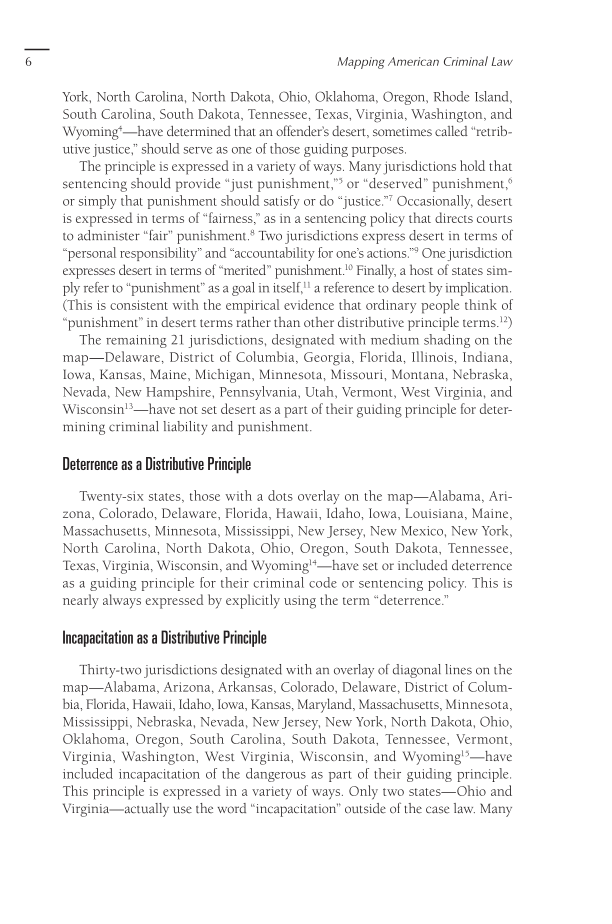6 Mapping American Criminal Law York, North Carolina, North Dakota, Ohio, Oklahoma, Oregon, Rhode Island, South Carolina, South Dakota, Tennessee, Texas, Virginia, Washington, and Wyoming4—have determined that an offender’s desert, sometimes called “retrib- utive justice,” should serve as one of those guiding purposes. The principle is expressed in a variety of ways. Many jurisdictions hold that sentencing should provide “just punishment,”5 or “deserved” punishment,6 or simply that punishment should satisfy or do “justice.”7 Occasionally, desert is expressed in terms of “fairness,” as in a sentencing policy that directs courts to administer “fair” punishment.8 Two jurisdictions express desert in terms of “personal responsibility” and “accountability for one’s actions.”9 One jurisdiction expresses desert in terms of “merited” punishment.10 Finally, a host of states sim- ply refer to “punishment” as a goal in itself,11 a reference to desert by implication. (This is consistent with the empirical evidence that ordinary people think of “punishment” in desert terms rather than other distributive principle terms.12) The remaining 21 jurisdictions, designated with medium shading on the map—Delaware, District of Columbia, Georgia, Florida, Illinois, Indiana, Iowa, Kansas, Maine, Michigan, Minnesota, Missouri, Montana, Nebraska, Nevada, New Hampshire, Pennsylvania, Utah, Vermont, West Virginia, and Wisconsin13—have not set desert as a part of their guiding principle for deter- mining criminal liability and punishment. Deterrence as a Distributive Principle Twenty-six states, those with a dots overlay on the map—Alabama, Ari- zona, Colorado, Delaware, Florida, Hawaii, Idaho, Iowa, Louisiana, Maine, Massachusetts, Minnesota, Mississippi, New Jersey, New Mexico, New York, North Carolina, North Dakota, Ohio, Oregon, South Dakota, Tennessee, Texas, Virginia, Wisconsin, and Wyoming14—have set or included deterrence as a guiding principle for their criminal code or sentencing policy. This is nearly always expressed by explicitly using the term “deterrence.” Incapacitation as a Distributive Principle Thirty-two jurisdictions designated with an overlay of diagonal lines on the map—Alabama, Arizona, Arkansas, Colorado, Delaware, District of Colum- bia, Florida, Hawaii, Idaho, Iowa, Kansas, Maryland, Mas sa chusetts, Minnesota, Mississippi, Nebraska, Nevada, New Jersey, New York, North Dakota, Ohio, Oregon, South Carolina, South Dakota, Tennessee, Vermont, Oklahoma, Virginia, Washington, West Virginia, Wisconsin, and Wyoming15—have included incapacitation of the dangerous as part of their guiding principle. This principle is expressed in a variety of ways. Only two states—Ohio and Virginia—actually use the word “incapacitation” outside of the case law. Many
Document Details My Account Print multiple pages
Print
You have printed 0 times in the last 24 hours.
Your print count will reset on at .
You may print 0 more time(s) before then.
You may print a maximum of 0 pages at a time.

































































































































































































































































































































































